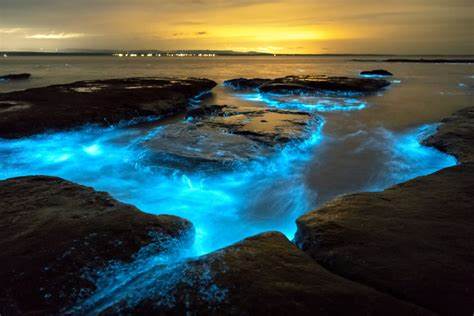What is bioluminescence? At its core, bioluminescence is the natural phenomenon where living organisms produce light through biochemical reactions. This captivating spectacle can be observed in various species ranging from fireflies to deep-sea creatures. The allure and wonder encapsulated within this biological marvel have fascinated scientists and nature enthusiasts alike for centuries, leading to a deeper exploration of its mechanisms, purposes, and implications in our ecosystem.

The Science Behind Bioluminescence
Delving into the scientific underpinnings of bioluminescence reveals a complex interplay of biochemical processes that enable organisms to emit light. Understanding these processes not only demystifies this phenomenon but also opens doors to various applications in fields such as medicine and environmental science.
The Biochemical Mechanism
Bioluminescence primarily results from a reaction between a light-emitting molecule known as luciferin and an enzyme called luciferase. When luciferin is oxidized in the presence of luciferase, light is produced.
The structure of luciferin varies significantly across different organisms, leading to the distinct colors of light emitted by various species. For instance, some marine organisms exhibit blue or green light, while others might emit red or yellow light. This variation is a result of factors like the environment, temperature, and even the pH level, showcasing the adaptability of these organisms.
Furthermore, the process of bioluminescence is highly efficient; nearly all the energy generated during the reaction is transformed into light rather than heat. This efficiency offers insights into evolutionary advantages, as organisms can attract mates or prey without revealing their presence to predators.
Evolutionary Perspectives
The evolution of bioluminescence is a riveting subject that highlights the complexity of life on Earth. It is believed that bioluminescence has independently evolved in multiple lineages. Such convergence suggests a strong selective advantage for those who possess this ability.
One compelling theory revolves around the use of bioluminescence for communication and signaling. Many species, such as fireflies, utilize specific patterns of light to attract potential mates or ward off rivals. In this context, bioluminescence serves not only as a survival mechanism but also as a critical component of reproductive strategies.
Moreover, in the depths of the ocean, where sunlight cannot penetrate, bioluminescence plays a crucial role in the survival of certain marine organisms. Species such as the anglerfish rely on their bioluminescent lures to attract unsuspecting prey, demonstrating how this adaptation can lead to successful hunting strategies in a dark environment.
Applications of Bioluminescence in Research
The study of bioluminescence extends beyond understanding the phenomenon itself; it has practical applications in various fields. Bioluminescent proteins, particularly luciferase, are widely used as markers in molecular biology and genetic research.
Researchers employ luciferase genes as a tool for monitoring gene expression and protein interactions. By attaching luciferase to a target gene, scientists can track the activity of that gene within living cells, providing real-time insights into cellular processes. This technique has significant implications for cancer research, drug development, and understanding various diseases at the molecular level.
Additionally, the potential for bioluminescence in environmental monitoring is becoming increasingly apparent. By engineering bioluminescent organisms, scientists can create bioindicators to detect pollutants in waterways. These organisms can signal changes in their environment, thus offering a more sustainable approach to environmental monitoring than traditional methods.
The Diversity of Bioluminescent Organisms
Bioluminescence is not restricted to a handful of species; it spans across a wide range of organisms, each utilizing this fascinating ability in unique ways. From terrestrial insects to deep-sea fish, the diversity of bioluminescent creatures enriches our understanding of this captivating phenomenon.

Terrestrial Bioluminescent Creatures
When considering what is bioluminescence, many people often think of fireflies. These small beetles utilize bioluminescence to communicate with potential mates. The males produce light signals, which females respond to, creating a mesmerizing dance of flickering lights in warm summer evenings.
Fireflies exhibit a complex courtship ritual that varies by species, showcasing the intricacies of communication through light. Interestingly, various species of fireflies have differing flash patterns, which serve as identifiers for mating partners. Each species has adapted its flashing behavior to optimize attraction, demonstrating evolution’s profound influence on behavioral traits.
Another terrestrial contender is the glowworm, a larval stage of certain beetle species. Found in caves and damp areas, glowworms produce bioluminescent threads that trap insects. The glowing silk acts as a lure, drawing prey closer before ensnaring them. This strategy showcases an alternative use of bioluminescence, emphasizing its role in predation and survival in the terrestrial realm.
Marine Bioluminescent Species
In the oceans, bioluminescence reaches astonishing diversity and complexity. From jellyfish to plankton, the underwater world thrives with organisms that produce light. One well-known example is the dinoflagellates, single-celled organisms that illuminate waves and shorelines. Their bioluminescence can create breathtaking displays, often resembling starry skies mirrored in the water at night.
Some deep-sea creatures take bioluminescence a step further. The anglerfish, for instance, possesses a bioluminescent lure that protrudes from its head, attracting prey in the abyssal depths. This adaptation is vital for survival in an environment where sight is limited, highlighting the resourcefulness of life in challenging habitats.
Another remarkable example includes the lanternfish, which is one of the most abundant vertebrates in the ocean. Lanternfish possess photophores, specialized light-producing organs along their bodies. These organs help them evade predators by allowing them to blend seamlessly with faint light from above when viewed from below.
The Role of Bioluminescence in Ecosystems
Bioluminescence plays a significant role in the functioning of ecosystems. Its effects ripple through the food chain, influencing predator-prey dynamics, mating behaviors, and ecological interactions. The intricate relationships formed through bioluminescence are a testament to nature’s complexity and interconnectedness.
For instance, bioluminescent plankton forms the base of the marine food web, providing nourishment for a variety of larger organisms. Their luminous properties not only attract prey but can also deter predators. When threatened, bioluminescent organisms may release clouds of light, disorienting attackers and increasing their chances of escape.
In addition, bioluminescence facilitates cooperation among species. Certain marine animals, like the symbiotic relationship between the clownfish and sea anemones, demonstrate how bioluminescence reinforces bonds within ecosystems. Bioluminescent signals can aid in recognizing kin, promoting social structures and enhancing survival rates among species.
Cultural Significance of Bioluminescence
Beyond its scientific marvel, bioluminescence holds significant cultural importance. Across various societies, the enchanting light produced by bioluminescent organisms has inspired myths, art, and literature, reflecting humanity’s longstanding fascination with nature’s wonders.
Myths and Folklore
Throughout history, bioluminescent creatures have sparked countless myths and legends. Fireflies, for example, have been depicted as spirits or guiding lights in many cultures, symbolizing hope and guidance. In various traditions, they are thought to carry messages from the spiritual realm, illuminating the darkness both literally and metaphorically.
Similarly, the glowing waters of dinoflagellates have inspired numerous tales of “ghosts” haunting the shores. In coastal regions, fishermen recount stories of mermaids dancing among the waves, illuminated by the ethereal glow of bioluminescent plankton. Such narratives illustrate how bioluminescence transcends mere observation, weaving itself into the fabric of human culture.
Artistic Interpretations
Artists worldwide have drawn inspiration from the captivating beauty of bioluminescence. Visual artists often depict glowing landscapes, showcasing the surreal and magical aspects of light in nature. Photographers capture the fleeting moments when fireflies dot the night sky or when glowing waves crash against the shore.
In literature, bioluminescence serves as a powerful metaphor for transformation and illumination. Writers evoke images of light emerging from darkness, reflecting the journey of self-discovery or enlightenment. These artistic interpretations highlight how bioluminescence continues to resonate deeply within the human experience.
Ecotourism and Conservation
The allure of bioluminescence has led to the rise of ecotourism focused on experiencing this natural wonder. Coastal areas hosting bioluminescent phenomena, such as Mosquito Bay in Vieques, Puerto Rico, draw tourists eager to witness the enchanting glow firsthand. While ecotourism can promote awareness and conservation, it also raises concerns about the impact of human activity on delicate ecosystems.
Sustainable practices are essential to preserving these unique environments. Initiatives that encourage responsible tourism can ensure that future generations continue to enjoy the magic of bioluminescence without compromising the integrity of the ecosystems that sustain it.

Conclusion
In exploring the question of what is bioluminescence, we uncover a multifaceted phenomenon that intertwines science, culture, and ecology. From the intricate biochemical mechanisms to the diverse array of organisms exhibiting this captivating trait, bioluminescence represents the wonders of the natural world.
Engaging with this subject leads us to appreciate not only the elegance of nature but also the stories and meanings embedded within these luminous displays. As we continue to study and understand bioluminescence, we are reminded of our connection to the broader tapestry of life, where light emerges from darkness, guiding our path forward in a world full of mysteries yet to be uncovered.

